Swivl is a personal robot operator. Made by KickStarter
Today I have not a phone on my desk or even a 3D printer, but a real robot. True small.
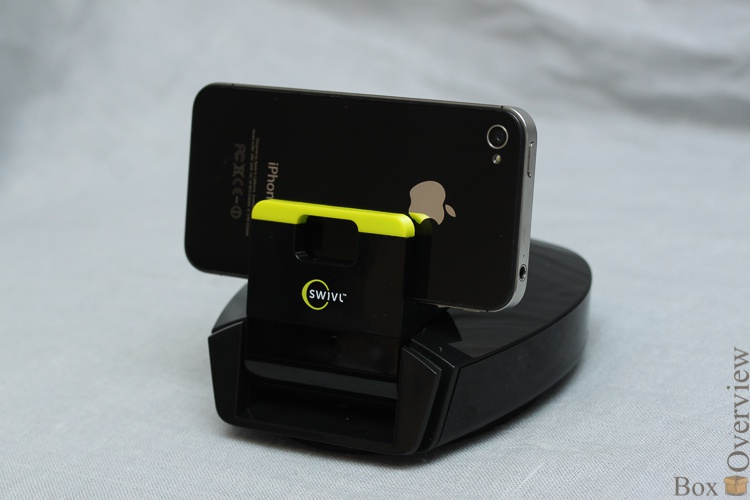
He will not bring you beer from the fridge, but it may well be your personal operator.
Swivl is a small platform on which a camera or iPhone is placed, and which monitors your movements, turning the camera towards you, which way you would go. I agree, the device is quite specific, and as a home gadget, it is not suitable for people who very often talk on Skype, and at the same time walk around the room.
But such a device was appreciated by lecturers, video podcasters, all sorts of extreme lovers - that is, those people who need to shoot themselves, but who still do not have a personal operator :)
I was interested in this device by the fact that Grishin Robotics (the company of Dmitry Grishin, CEO of Mail.Ru Group) invested in the production of the second version of the robot a rather large amount in support of Western robotic startups.
I wrote a slightly incorrect heading, because the funds for the first generation of Swivl were collected not on KickStarter, but on IndieGoGo . And then he was not called Swivl, but simply Satarii Star Accessory. Nevertheless, the money was successfully raised (although $ 20k for such a project and production was a penny), and the gadget was released. It took quite a lot of time, and he appeared on the table with us in Box Overview.
')
► Appearance
Let's start as usual with the box:

Perhaps the box is unusual only because the interior does not move completely and the gray end protrudes. However, it is very convenient for him to open the box without using nails or crutches in the form of ropes on the end. Side - description of the configuration:

In the lower part - insurance. Well, just in case, suddenly someone did not understand:

Above - lists supported devices:
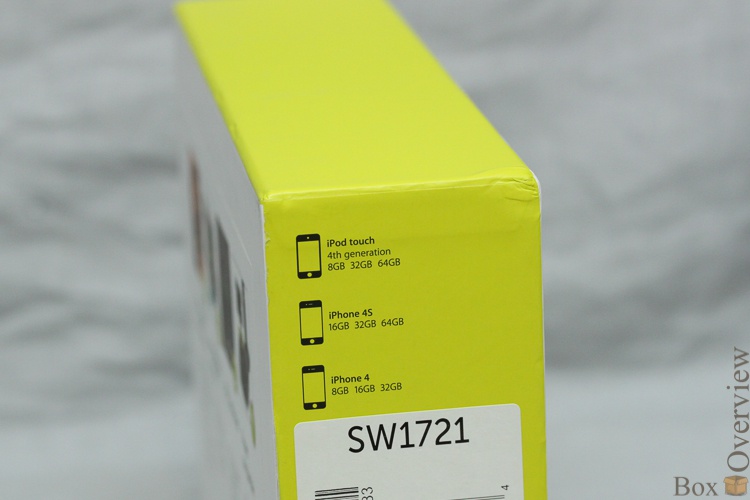
And behind - the main functions:
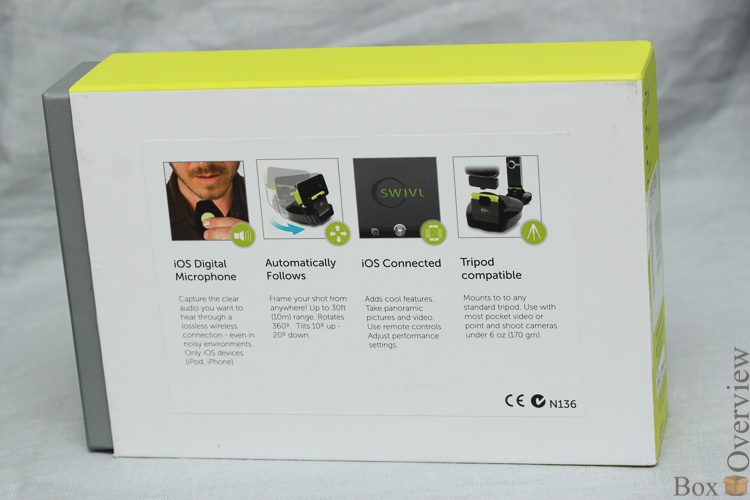
When opening the box, we are first met by an inscription explaining the purpose of the device:

And then the device itself:
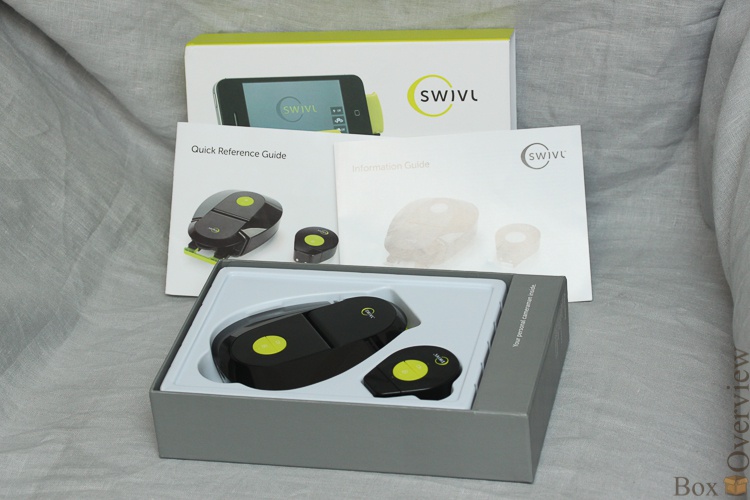
Completion, by the way, quite ascetic:
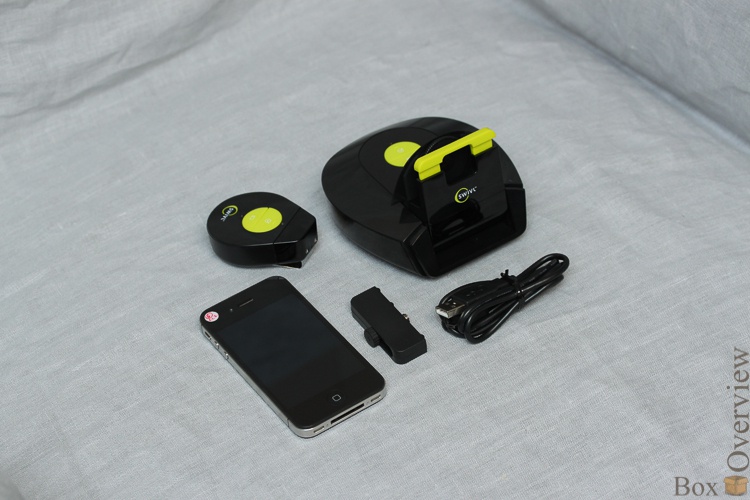
By the way, despite the inscription, my iPhone was bundled :) Besides it, there was a manual, the platform itself, a marker with a string around the neck:

There was also an adapter for mounting cameras with a tripod mount, and a microUSB cable. The latter is used, as I understand it, only to power the device.
Here is the platform itself:

Front end - mount for phone or camera:
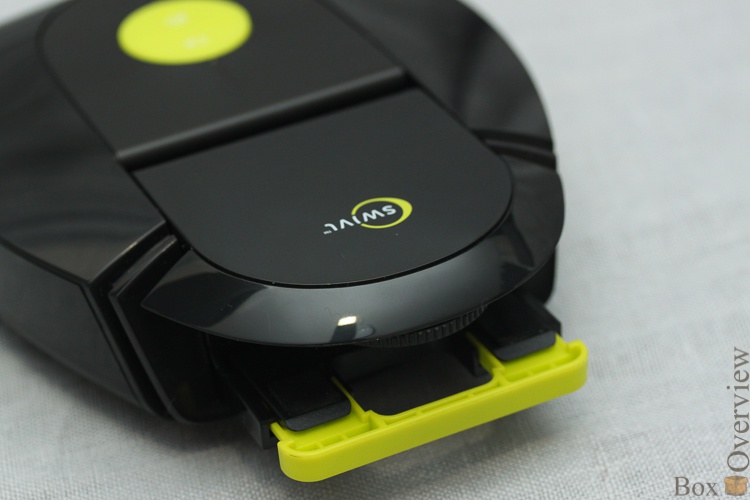
In operating mode, it rises to the top:

And it installs something that can record video:
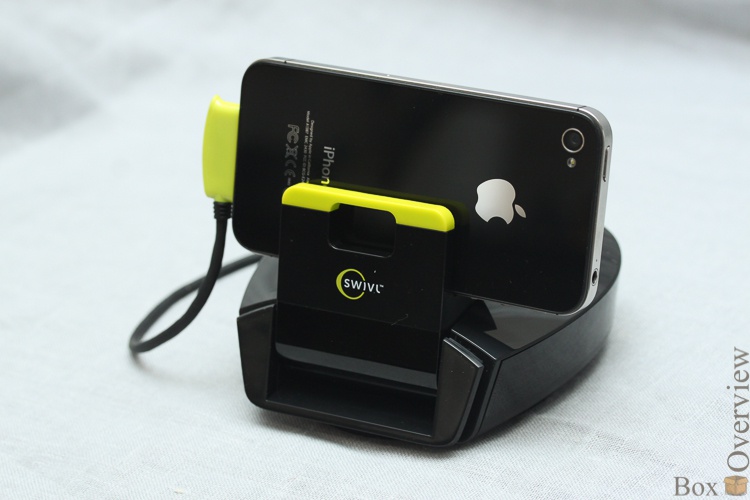
The green spot in the middle is two buttons and two LEDs next to them.

On the side there is a slot for two AA batteries:
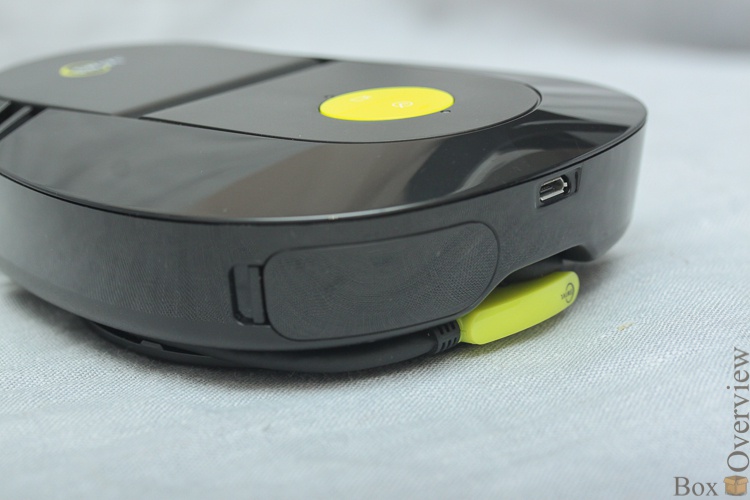
Behind - MIcroUSB and cable with a 30-pin plug:
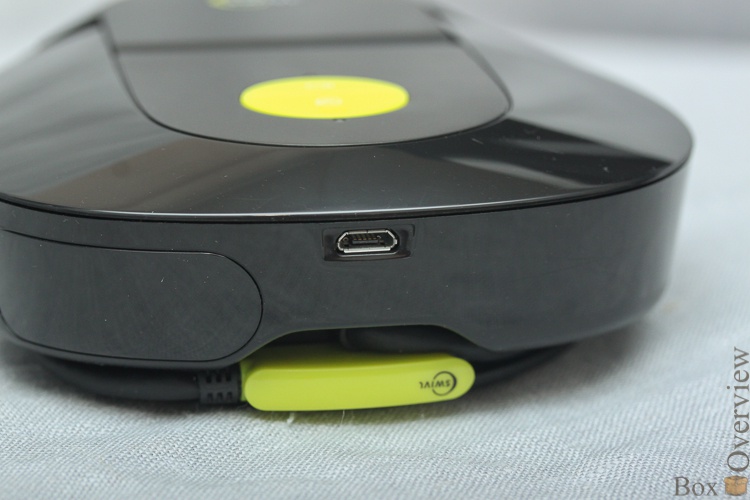
The cable is wrapped around the stand and, if necessary, is unwound and connected to the phone:
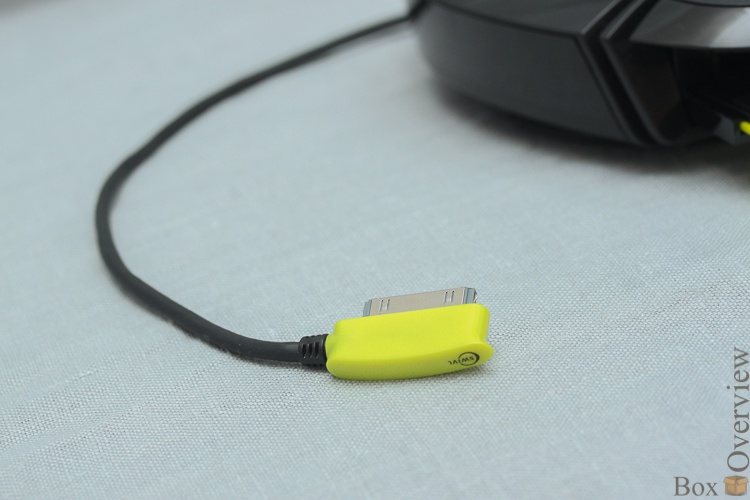
On the bottom - information and mounting for installation on a standard tripod:

Around all of this is a black strip of rubber that keeps well on most dense materials, preventing the device from moving during abrupt maneuvers.
The marker sensor looks like a smaller copy of the platform:

On the front surface - the same two buttons with LEDs:
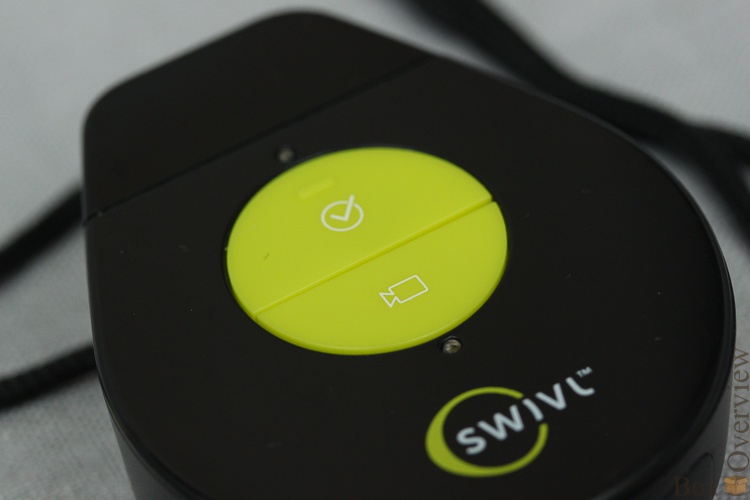
Below is the battery compartment (two pieces of AAA):
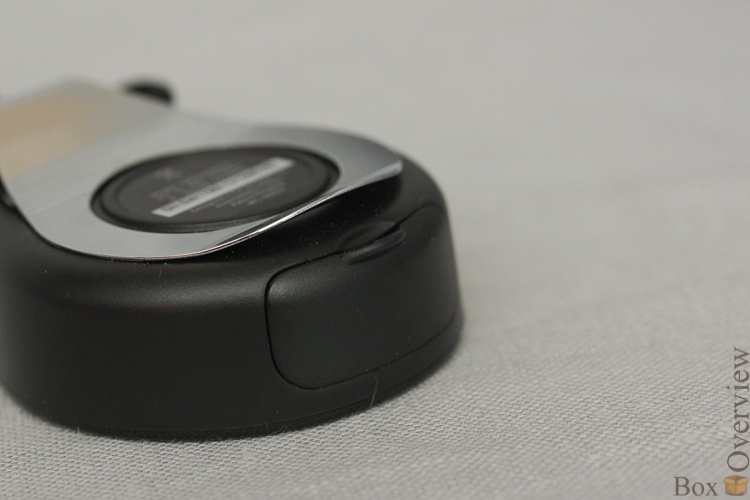
On the back wall there is a sticker with information and a clip for clothes.

The upper part is covered with plastic, under which the LEDs and the microphone are hidden:
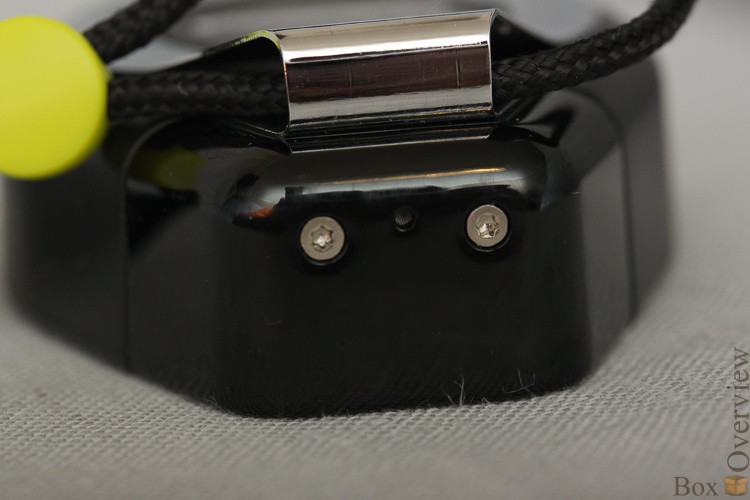
► Work
First, you need to include both the platform and the marker. As the instruction tells us, this is done by long pressing the button with the image of the video camera, after which the red LED lights up:
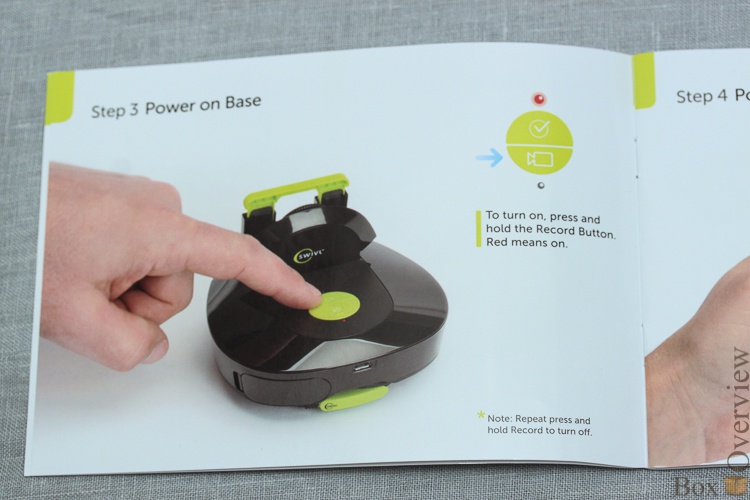
And there is:
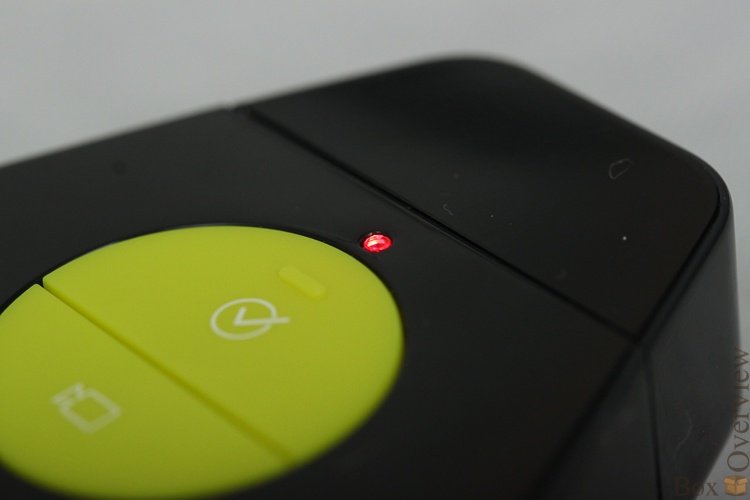
After the same operation with the sensor, the color of the LEDs changes to green:

Now you can install the phone in the mount, turn it on:

And the platform will automatically rotate after the sensor, constantly keeping its owner in sight. At the same time, the Swivl can be mounted on a tripod for easy height adjustment:
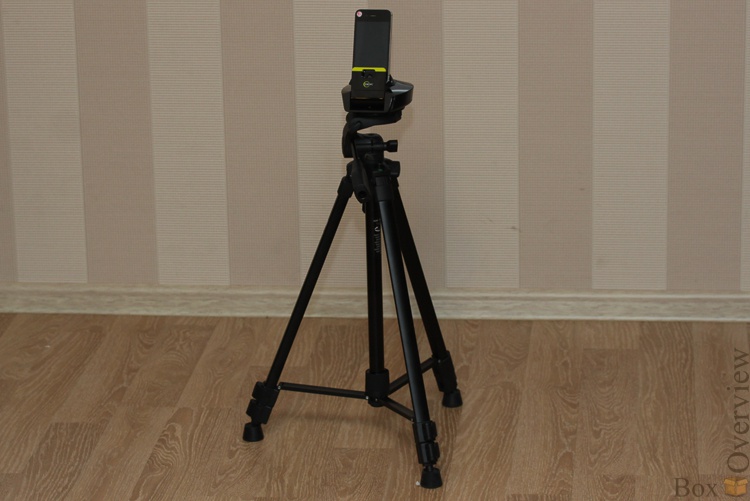
But it will be much more convenient if you connect an iPhone with a wire and download a special program from the AppStore:

After that, it will be possible to control the level of charge of the base and sensor:
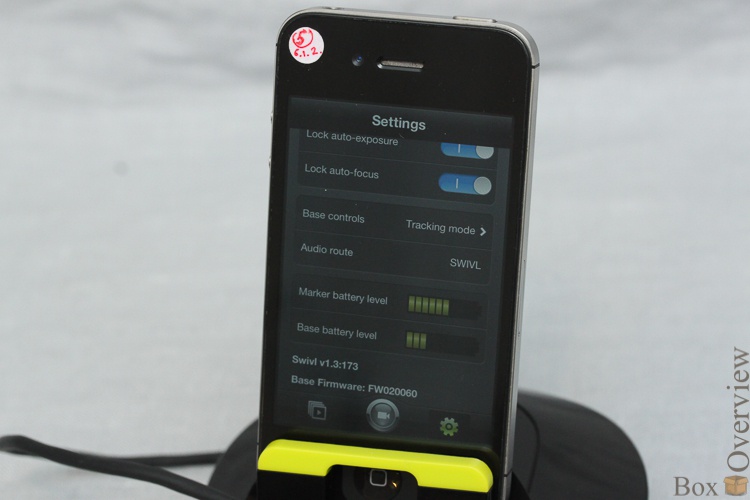
Adjust the speed of rotation (normal or tracking sports objects - the mode in which the operator rotates as fast as possible after the object) and automatic rotation in the vertical plane:
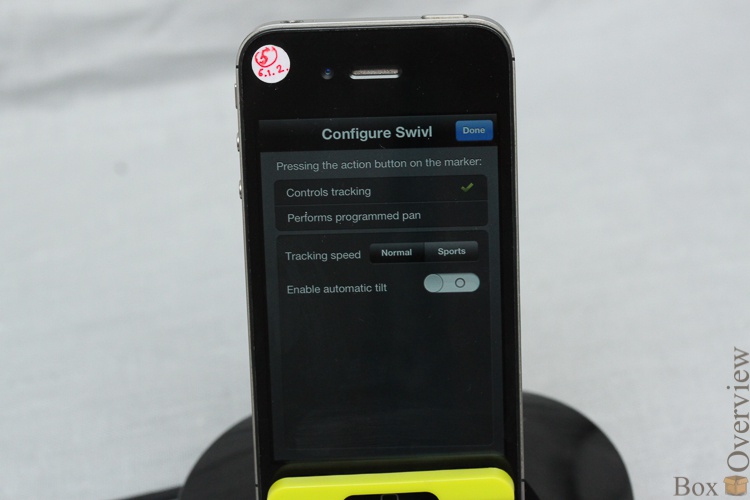
Or even disable tracking, replacing it with a “camera tracking” mode - a slow rotation in one and the other direction:
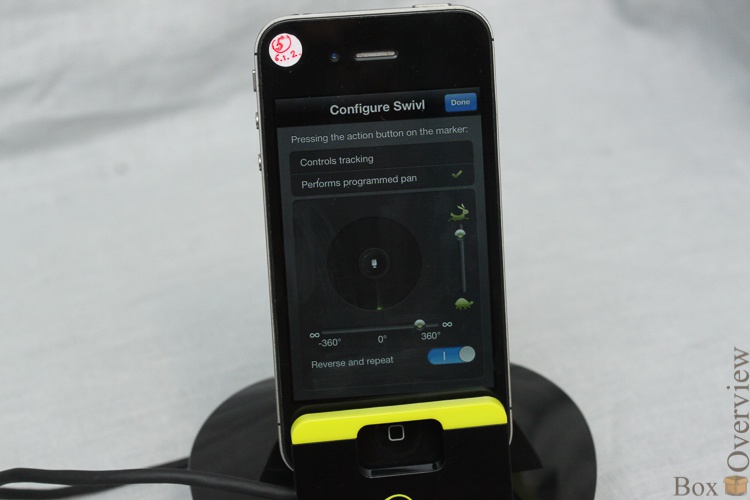
But the main advantage of the program is not in the settings, but in the fact that it can write video with the sound received from the microphone of the marker. No matter how loud the room in which the operator will stand, the sound of the speaker’s voice will always be good - the marker is located as close as possible to the sound source.
The mount is universal, and supports both vertical installation:

For example, for video conferencing or chatting via Skype. And the horizontal installation, to use the rear camera, which gives the picture is still much better:
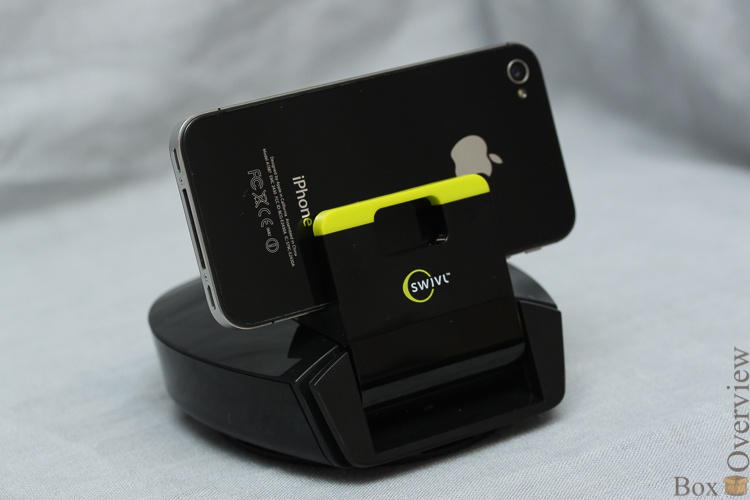
With the mount you can install almost any camera:

With the condition that its weight should not exceed 160 grams - SLRs and system cameras for the most part disappear. True, I put on the Lumix G2 mount weighing 600 grams, and the platform still moved it after me, though not as fast as the phone.
You can see shooting examples in the video review of my colleagues at Iphones.ru:
In the meantime, we will deal with a much more interesting thing - an autopsy. More precisely the guts, because at three o'clock in the morning I completely forgot to photograph the disassembly process. I think it will not upset anyone, since I hope that very few of my readers will have the chance to disassemble it. Disassembly, by the way, is rather nontrivial, and is associated with the constant feeling that now something will break. Okay, trash!
► Internals
Here is the main board of the device:

A controller from ST, namely STM32F105, is used as the central processor. It was probably chosen because it has a built-in USB interface.
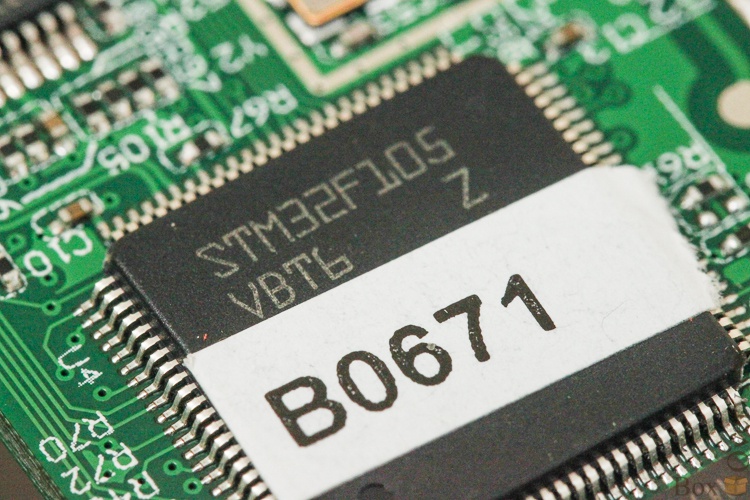
What is noteworthy is that the USB controller is connected to both the 30-pin connector and the rear MicroUSB connector. Of course, not at the same time - switching is controlled by such a wonderful microcircuit (a square case without legs next to two resistors), which is a multiplexer of differential lines:
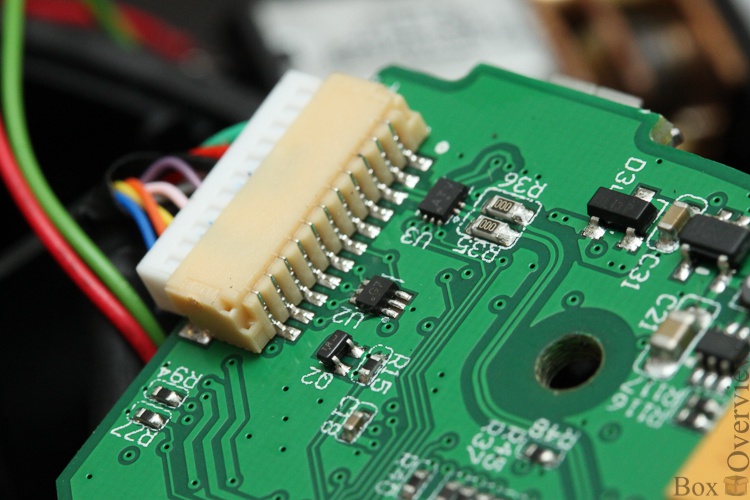
Therefore, if you connect the robot to the computer, nothing will happen - to switch, you must still give the command to the switch. Since in the course of normal use such a solution is not used, I assume that this was done to update the firmware or some service functions.
Nearby is a wireless two-channel audio transceiver from Texas Instruments - CC8520, which provides sound transmission from the marker for high-quality recording:
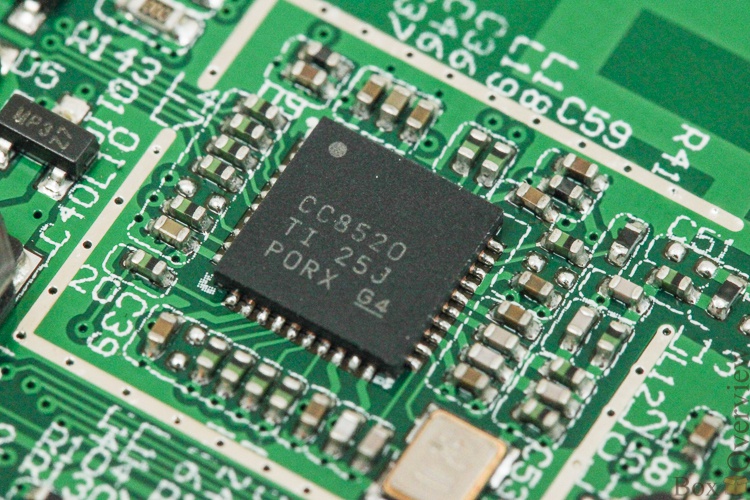
I suspect that his brother is in the console. A little higher - there is a Step-up also from TI, which makes from 2-3 volt battery power 5, necessary for the operation of the controller and motors:

On the reverse side, next to the connectors, there is a dual engine driver:

Here is the motor that turns the stand:
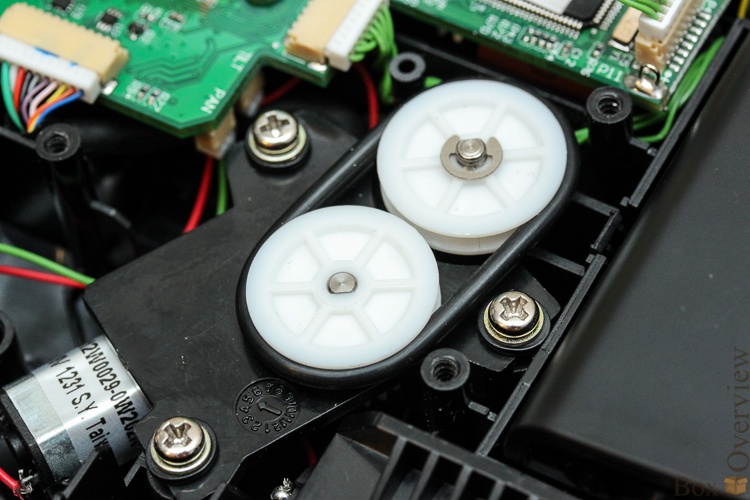
The stand, by the way, can rotate in any direction and for any number of turns - you can walk around it in circles, and everything will work.
And here is the second engine responsible for tilting the camera:
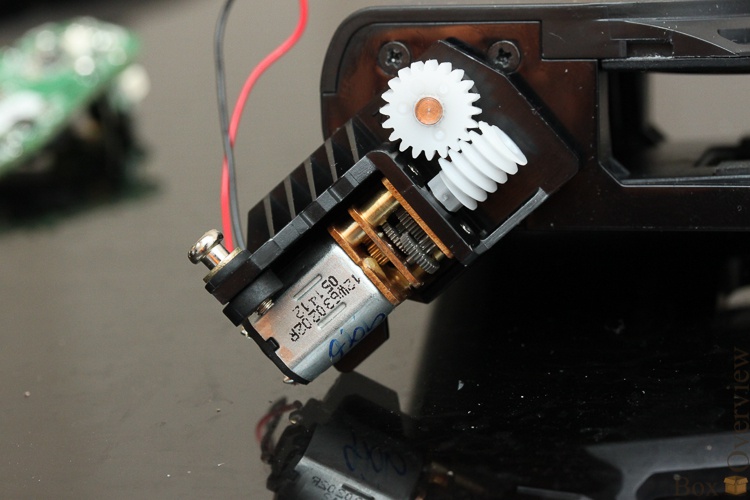
This engine, along with a metal gearbox (@DIHALT wrote just about such).
There are optical sensors on a rotating platform.
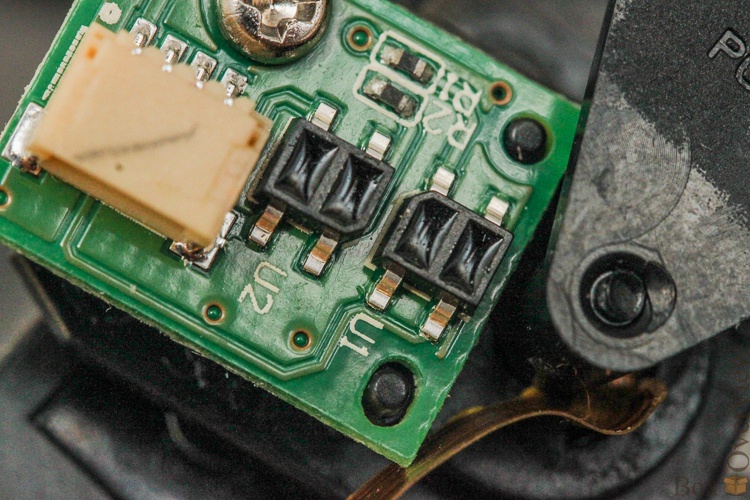
And the counterpart for them is the mirror:

They show the position of the platform, since the motor has no position sensors. According to it, the robot determines whether the platform is raised from a lying state or not - it will not work with the platform lowered.
We disassemble the lower part of the rotating platform, in which there are also sensors that monitor the marker:

Fee for IR-transparent plastic with a large plastic lens:

On the reverse side of the board there are several operational amplifiers (besides, low-noise and pre-amps):
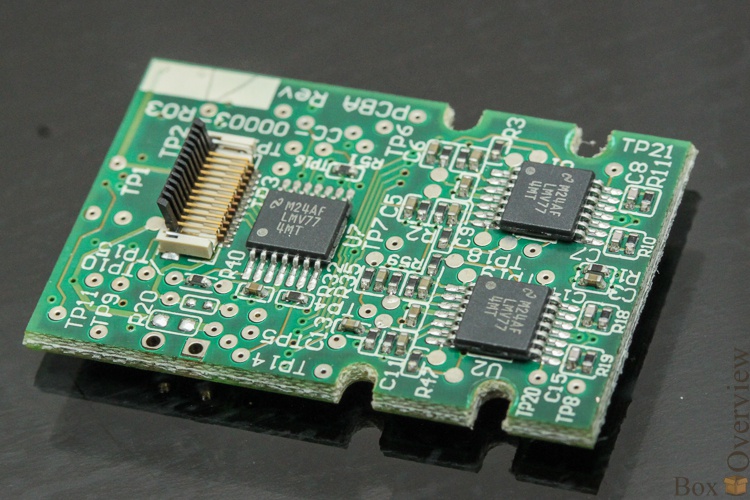
Overturn the board, remove the lens, and the OPA!

Instead of individual photodiodes (as I thought), there is such a “matrix” of its own, though of just 4 pixels. Apparently, this was done for greater sensitivity of the sensor. And 4 pieces are needed to determine the direction of movement not only left and right, but also up and down, in case the tracking object also moves vertically.
But by the way how does the mechanism of adjustment to the size of the phone. Just a wheel on the thread, which can be in this position:

But in this:

Now let's do the remote control. General front view:
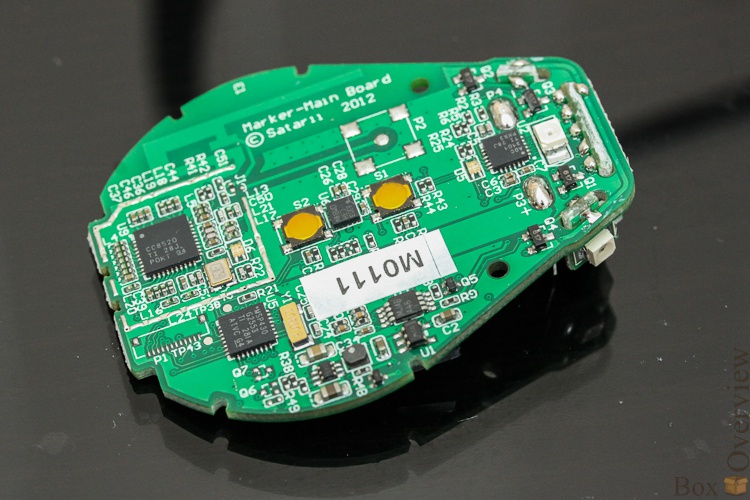
General rear view:

As a supplier of component parts, manufacturers follow an enviable consistency - MSP430 from TI is used as a processor. Well, like them. I also like TI.
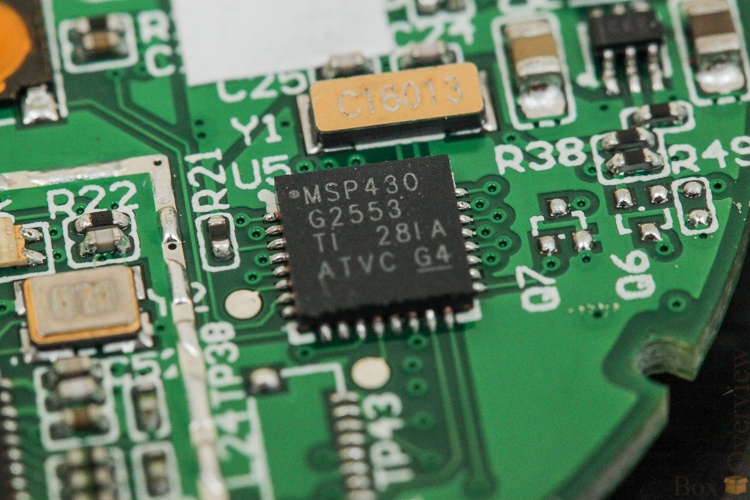
As expected, the twin brother of CC8520:
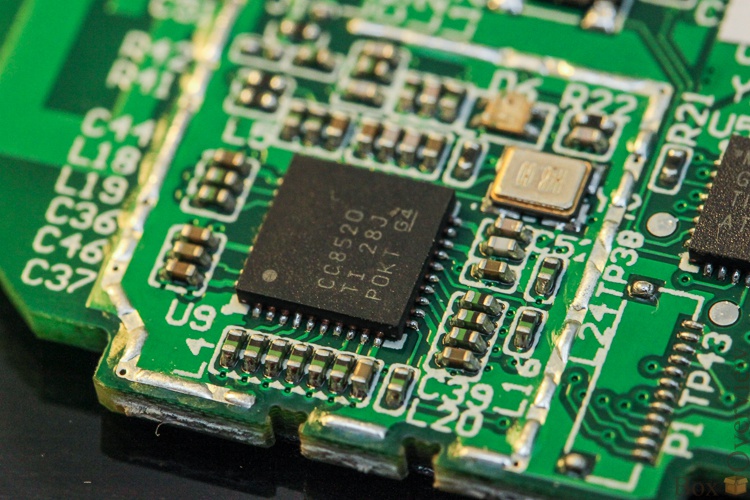
On the top there are a lot of infrared LEDs and a microphone:
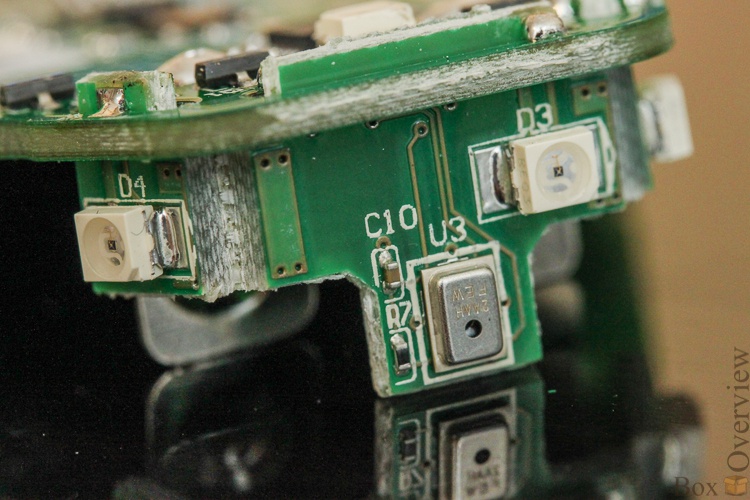
Another LED remained on the top board:

Near TLV320ADC3101 - ADC sharpened for wireless sound transmission. Also from TI.
 Review from iphones.ru
Review from iphones.ru
 Official site
Official site
 The project on Kickstarter second-generation consoles
The project on Kickstarter second-generation consoles
 CEO Mail.Ru Group will invest $ 500 thousand in the Swivl video robot
CEO Mail.Ru Group will invest $ 500 thousand in the Swivl video robot
If you do not have an account on Habrahabr, you can read and comment on our articles on BoxOverview.com

He will not bring you beer from the fridge, but it may well be your personal operator.
Swivl is a small platform on which a camera or iPhone is placed, and which monitors your movements, turning the camera towards you, which way you would go. I agree, the device is quite specific, and as a home gadget, it is not suitable for people who very often talk on Skype, and at the same time walk around the room.
But such a device was appreciated by lecturers, video podcasters, all sorts of extreme lovers - that is, those people who need to shoot themselves, but who still do not have a personal operator :)
I was interested in this device by the fact that Grishin Robotics (the company of Dmitry Grishin, CEO of Mail.Ru Group) invested in the production of the second version of the robot a rather large amount in support of Western robotic startups.
I wrote a slightly incorrect heading, because the funds for the first generation of Swivl were collected not on KickStarter, but on IndieGoGo . And then he was not called Swivl, but simply Satarii Star Accessory. Nevertheless, the money was successfully raised (although $ 20k for such a project and production was a penny), and the gadget was released. It took quite a lot of time, and he appeared on the table with us in Box Overview.
')
► Appearance
Let's start as usual with the box:
Perhaps the box is unusual only because the interior does not move completely and the gray end protrudes. However, it is very convenient for him to open the box without using nails or crutches in the form of ropes on the end. Side - description of the configuration:

In the lower part - insurance. Well, just in case, suddenly someone did not understand:

Above - lists supported devices:

And behind - the main functions:

When opening the box, we are first met by an inscription explaining the purpose of the device:

And then the device itself:

Completion, by the way, quite ascetic:

By the way, despite the inscription, my iPhone was bundled :) Besides it, there was a manual, the platform itself, a marker with a string around the neck:

There was also an adapter for mounting cameras with a tripod mount, and a microUSB cable. The latter is used, as I understand it, only to power the device.
Here is the platform itself:

Front end - mount for phone or camera:

In operating mode, it rises to the top:

And it installs something that can record video:

The green spot in the middle is two buttons and two LEDs next to them.

On the side there is a slot for two AA batteries:

Behind - MIcroUSB and cable with a 30-pin plug:

The cable is wrapped around the stand and, if necessary, is unwound and connected to the phone:

On the bottom - information and mounting for installation on a standard tripod:

Around all of this is a black strip of rubber that keeps well on most dense materials, preventing the device from moving during abrupt maneuvers.
The marker sensor looks like a smaller copy of the platform:

On the front surface - the same two buttons with LEDs:

Below is the battery compartment (two pieces of AAA):

On the back wall there is a sticker with information and a clip for clothes.

The upper part is covered with plastic, under which the LEDs and the microphone are hidden:

► Work
First, you need to include both the platform and the marker. As the instruction tells us, this is done by long pressing the button with the image of the video camera, after which the red LED lights up:
And there is:

After the same operation with the sensor, the color of the LEDs changes to green:

Now you can install the phone in the mount, turn it on:

And the platform will automatically rotate after the sensor, constantly keeping its owner in sight. At the same time, the Swivl can be mounted on a tripod for easy height adjustment:

But it will be much more convenient if you connect an iPhone with a wire and download a special program from the AppStore:

After that, it will be possible to control the level of charge of the base and sensor:

Adjust the speed of rotation (normal or tracking sports objects - the mode in which the operator rotates as fast as possible after the object) and automatic rotation in the vertical plane:

Or even disable tracking, replacing it with a “camera tracking” mode - a slow rotation in one and the other direction:

But the main advantage of the program is not in the settings, but in the fact that it can write video with the sound received from the microphone of the marker. No matter how loud the room in which the operator will stand, the sound of the speaker’s voice will always be good - the marker is located as close as possible to the sound source.
The mount is universal, and supports both vertical installation:

For example, for video conferencing or chatting via Skype. And the horizontal installation, to use the rear camera, which gives the picture is still much better:

With the mount you can install almost any camera:

With the condition that its weight should not exceed 160 grams - SLRs and system cameras for the most part disappear. True, I put on the Lumix G2 mount weighing 600 grams, and the platform still moved it after me, though not as fast as the phone.
You can see shooting examples in the video review of my colleagues at Iphones.ru:
In the meantime, we will deal with a much more interesting thing - an autopsy. More precisely the guts, because at three o'clock in the morning I completely forgot to photograph the disassembly process. I think it will not upset anyone, since I hope that very few of my readers will have the chance to disassemble it. Disassembly, by the way, is rather nontrivial, and is associated with the constant feeling that now something will break. Okay, trash!
► Internals
Here is the main board of the device:

A controller from ST, namely STM32F105, is used as the central processor. It was probably chosen because it has a built-in USB interface.

What is noteworthy is that the USB controller is connected to both the 30-pin connector and the rear MicroUSB connector. Of course, not at the same time - switching is controlled by such a wonderful microcircuit (a square case without legs next to two resistors), which is a multiplexer of differential lines:

Therefore, if you connect the robot to the computer, nothing will happen - to switch, you must still give the command to the switch. Since in the course of normal use such a solution is not used, I assume that this was done to update the firmware or some service functions.
Nearby is a wireless two-channel audio transceiver from Texas Instruments - CC8520, which provides sound transmission from the marker for high-quality recording:

I suspect that his brother is in the console. A little higher - there is a Step-up also from TI, which makes from 2-3 volt battery power 5, necessary for the operation of the controller and motors:

On the reverse side, next to the connectors, there is a dual engine driver:

Here is the motor that turns the stand:

The stand, by the way, can rotate in any direction and for any number of turns - you can walk around it in circles, and everything will work.
And here is the second engine responsible for tilting the camera:

This engine, along with a metal gearbox (@DIHALT wrote just about such).
There are optical sensors on a rotating platform.

And the counterpart for them is the mirror:

They show the position of the platform, since the motor has no position sensors. According to it, the robot determines whether the platform is raised from a lying state or not - it will not work with the platform lowered.
We disassemble the lower part of the rotating platform, in which there are also sensors that monitor the marker:

Fee for IR-transparent plastic with a large plastic lens:

On the reverse side of the board there are several operational amplifiers (besides, low-noise and pre-amps):

Overturn the board, remove the lens, and the OPA!

Instead of individual photodiodes (as I thought), there is such a “matrix” of its own, though of just 4 pixels. Apparently, this was done for greater sensitivity of the sensor. And 4 pieces are needed to determine the direction of movement not only left and right, but also up and down, in case the tracking object also moves vertically.
But by the way how does the mechanism of adjustment to the size of the phone. Just a wheel on the thread, which can be in this position:

But in this:

Now let's do the remote control. General front view:

General rear view:

As a supplier of component parts, manufacturers follow an enviable consistency - MSP430 from TI is used as a processor. Well, like them. I also like TI.

As expected, the twin brother of CC8520:

On the top there are a lot of infrared LEDs and a microphone:

Another LED remained on the top board:

Near TLV320ADC3101 - ADC sharpened for wireless sound transmission. Also from TI.
Links
 Review from iphones.ru
Review from iphones.ru Official site
Official site The project on Kickstarter second-generation consoles
The project on Kickstarter second-generation consoles CEO Mail.Ru Group will invest $ 500 thousand in the Swivl video robot
CEO Mail.Ru Group will invest $ 500 thousand in the Swivl video robotIf you do not have an account on Habrahabr, you can read and comment on our articles on BoxOverview.com
Source: https://habr.com/ru/post/182422/
All Articles